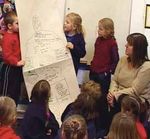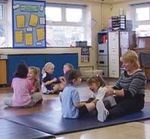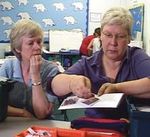Template for a school accessibility plan
←
→
Page content transcription
If your browser does not render page correctly, please read the page content below
Template for a
school accessibility plan
From this interactive version of the school template you can access different levels of
information for each aspect of the plan:
● notes and suggestions at the first level;
● more detailed information at the second level;
● information about specific resources, accessed from the resources box at the
third level.
Resources relevant to all aspects of plans and strategies can be accessed from the
box below:
Resources relevant to all aspects of strategies and plans
Audit Commission (2002) Special Educational Needs: A mainstream issue
Audit Commission (2002) Managing special educational needs: a self-review
handbook for local education authorities
Carlin J (2005) Including Me: Managing complex health needs in schools and early
years settings. Council for Disabled Children
DfES (2001) Access to education: for children and young people with medical needs
DfES (2002) Accessible Schools: Planning to increase access to schools for disabled
pupils
DfES/DoH (2005) Managing medicines in schools and early years settings
Meeting medical needs in mainstream education: a summary of survey findings
Suggested text for an introduction to a school plan is included in the Word version of the
template on the CD-ROM.
1Improving access for disabled pupils: school plans
1: Starting points
Click here for more information on starting points
1A: The purpose and direction of the school’s plan: vision
and values
Identify the school’s priorities for the development of the vision and values that inform
the plan:
●
●
●
Work these into more detail as a set of action plans.
Click here for more information on vision and values
1B: Information from pupil data and school audit
Identify the school’s priorities for the development of information and data to support the
school’s accessibility plan:
●
●
●
Work these into more detail as a set of action plans.
Click here for more information on information and data
1C: Views of those consulted during the development of the plan
Identify the school’s priorities in respect of consultation on the plan:
●
●
●
Work these into more detail as a set of action plans.
Click here for more information on consultation and involvement
2Chapter 3: Template for a school accessibility plan
2: The main priorities in the school’s plan
Click here for more information on the main priorities
2A: Increasing the extent to which disabled pupils can participate
in the school curriculum
Identify the school’s priorities for increasing curriculum access:
●
●
●
Work these into more detail as a set of action plans.
Click here for more information on access to the curriculum
2B: Improving the physical environment of the school to increase
the extent to which disabled pupils can take advantage of
education and associated services:
Identify the school’s priorities for physical improvements to increase access:
●
●
●
Work these into more detail in a set of action plans.
Click here for more information on improvements to the physical environment
2C: Improving the delivery to disabled pupils of information that
is provided in writing for pupils who are not disabled:
Identify the school’s priorities for providing information for disabled pupils:
●
●
●
Work these into more detail in a set of action plans.
Click here for more information on information for disabled pupils
3Improving access for disabled pupils: school plans
3: Making it happen
Click here for more information on making it happen
3A: Management, coordination and implementation
Identify the school’s priorities for the management, coordination and implementation of
the accessibility plan:
●
●
●
Work these into more detail as a set of action plans.
Click here for more information on management, co-ordination and implementation
3B: Getting hold of the school’s plan
Identify the school’s priorities for making its plan available:
●
●
●
Work these into more detail as a set of action plans.
Click here for more information on making the school’s plan available
4Improving access for
disabled pupils:
school plans
“How good is your school’s accessibility plan?”
“Where’s the best place to start when you review your plan?”
“Who do you need to consult about your plan?”
“How can your plan help you to promote equality of opportunity for disabled people under
the DDA 2005?”
The materials in this section can help you to answer these questions. They provide a template to
support you in developing an effective plan to improve access to education for disabled pupils.
The materials include:
● a summary of the requirements and principles of accessibility planning;
● criteria to help you judge the quality of your current plan;
● three versions of the template, with different levels of detail, to help you review and develop
your plan;
● materials that you can use in training and development work on the DDA planning duties.Improving access for disabled pupils: school plans
Improving access for disabled pupils:
school plans
Contents Page
1. How to use the materials 3
2. Accessibility planning for schools 5
● Requirements and principles 5
● Key messages for schools 7
3. Template for a school accessibility plan 9
● Template 1 11
● Template 2 19
4. References 49
5. Where are you now? Assessing your school accessibility plan 53
On the accompanying CD-ROM:
● Resources to support plans and strategies
● Training materials
● Accessibility Planning Project
● Improving access for disabled pupils: school plans word processed file1. How to use the materials
Accessibility planning has an important part to play in improving outcomes for
disabled pupils and raising standards in schools. Improving access for disabled pupils:
school plans is designed to provide schools with practical tools and materials to
support improvements in access for disabled pupils.
The materials in Improving access for disabled pupils: school plans were developed
through the Accessibility Planning Project (APP). APP worked with six partner local
authorities and their schools to develop the tools and materials in this section. The
written guide and the materials on the accompanying CD-ROM, can be used in a
number of different ways. They can be used:
● to steer the review and development of a school accessibility plan;
● as a toolbox to dip into where schools are looking for advice on particular aspects
of their plan;
● to support training on accessibility planning.
Improving access for disabled pupils: school plans is organised in two linked parts:
● the written guide
● CD-ROM
The written guide
The Template for a school accessibility plan, page 9, is the main tool in the written
guide. It is designed to help schools review and develop their accessibility plans.
The template recommends a number of different sections for an effective plan.
Different versions of the template provide different levels of detail on each section:
● Template 1: the template with notes
● Template 2: the template in detail.
On the CD-ROM there is:
● an ‘empty’ version which can be adapted for schools’ own use;
● an interactive option that enables users to move between different levels of
detail and to access the supporting case studies and other resources.
A section in the written guide, Where are you now? Criteria for assessing your
accessibility plan, provides criteria to enable schools to assess the quality of their
accessibility plan. Using the criteria can help a school to see:
● which areas of their plan work well; and
● which areas of their plan may need developing.
3Improving access for disabled pupils: school plans
The CD-ROM includes:
Resources
The resources are designed to provide a toolbox of ideas and examples to support
local authorities in developing different aspects of their accessibility strategy.
The resources include a variety of different materials:
● brief summaries of and extracts from official guidance;
● relevant information from a variety of other published sources; and
● useful tools and case studies from APP, including accounts of particular
approaches taken in a school or local authority.
Training materials
Accessibility planning needs to proceed from an accurate and shared understanding
of what the DDA requires and, in particular, a shared understanding of the definition
of disability. Training has an important part to play in this.
The Training materials on the CD-ROM include:
● sample training sessions: these combine briefings and presentations with
resources and activities;
● briefings on:
– the disability discrimination duties;
– the accessibility planning duties;
– the definition of disability in the DDA;
● annotated PowerPoint presentations, including presentations on:
– the disability discrimination duties;
– the accessibility planning duties.
The Accessibility Planning Project
APP worked with six partner local authorities and their schools to produce the tools
and resources in this guide and on the accompanying CD-ROM. This section on the
CD-ROM includes:
● a description of APP and the work carried out with the partner authorities;
● an account of two analyses of strategies that were undertaken as part of
the Project;
● an account of the analyses of a sample of school plans from two of the partner
authorities.
These analyses of plans and strategies helped to set the priorities for the work with
the local authorities and their schools. They also indicate where strengths and
weaknesses may lie in plans and strategies in other local authorities.
The written guide
The text of this section of the written resource is also available on the CD-ROM,
so that:
● materials can be copied and used in training and development activities; and
● text can be converted into other formats, for example large font, for increased
accessibility.
The planning tools, Duties and definitions and some of the supporting materials are
also available on the Teachernet website: www.teachernet.gov.uk/wholeschool/sen/
schools/accessibility/accessibilityplanningproject/
42. Accessibility planning for schools
Requirements and principles
The Disability Discrimination Act 1995 (DDA) requires schools to have an accessibility
plan to improve access to education for disabled pupils over time. A companion
section to this one, Duties and definitions, provides more detail on the duties.
This section summarises the requirements and sets out some principles that
should inform how schools develop their plans.
Requirements
The school’s plan meets the statutory requirements when:
● it is in writing;
● it covers the three strands of increasing access over time:
– increased access to the curriculum for disabled pupils;
– improvements to the physical environment to increase access to
education and associated services at the school;
– improvements in the provision of information for disabled pupils
where it is provided in writing for pupils who are not disabled;
● it is:
– adequately resourced;
– implemented;
– reviewed;
– revised as necessary;
● it is renewed every three years;
● information about the accessibility plan is reported to parents annually.
5Improving access for disabled pupils: school plans
Principles
An effective plan:
● is rooted in a culture of high expectations for all;
● is guided by the National Curriculum Inclusion Statement and the aims
set out for the school curriculum;
● seeks out and responds to the views of key stakeholders;
● demonstrates a commitment to developing access to the school for all
pupils;
● supports a problem solving approach;
● shows a commitment to the effective and sustainable use of resources;
● is clear about how it will be evaluated.
A plan draws on a sound information base when it:
● uses information from audit and other data collection;
● reflects the use of evidence gathering and approaches validated by
research;
● uses outcome data to inform the development and evaluation of the
plan;
● reflects an understanding of the relationship between the SEN and
disability duties;
● reflects an understanding of other legislation that provides protection to
children, such as that on race, human rights and health and safety.
A plan supports partnership when it:
● shows how the school plan is coordinated with the local authority’s
strategy and demonstrates the benefits of a collaborative approach;
● is accessible to all;
● Is embedded in the school improvement process;
● reflects the wishes, aspirations and concerns of parents and pupils;
● dovetails with and permeates other school planning processes;
● sets out explicit links with the work of other agencies.
6Chapter 2: Accessibility planning for schools
Key messages for schools
APP worked with six partner local authorities and their schools to develop the
accessibility planning materials. On the basis of that work, some key issues
emerged. They are provided here to inform the further development of
schools’ plans.
The best plan for your school starts with your school and your pupils
Plans need to start with the school’s own information and data about their
disabled pupils, the school’s vision for their disabled pupils, and the views of
disabled pupils and their parents. Every school is different. Another school’s
plan is unlikely to be relevant to disabled pupils at your school.
There are more disabled pupils than you think
Crucial to effective planning is a clear understanding of: which pupils count
as disabled; and which pupils who might be coming to the school count as
disabled. Most people are surprised to find out how many are included in the
DDA definition.
Consultation is crucial
Consult and schools will get help in identifying their priorities. Consult pupils
and parents and schools will get good practical solutions to increasing
access for them. Consult early and schools are more likely to get help in
identifying low cost or no cost solutions.
Knowing where to go for support
Schools may need to supplement and complement their own expertise. A
range of different forms of support is available to most schools: supportive
colleague networks, specialist advisory support, different sections of the local
authority, other agencies, local and national voluntary organisations.
Nobody can do this on their own: these duties need a school
wide response
It needs everyone to take the lead in respect of accessibility within their area
of responsibility: access to the curriculum in the hands of those with
curriculum responsibilities; access to the pastoral life of the school in the
hands of those with pastoral responsibilities; and responsibility for
overseeing the plan rests with the senior managment team reporting to the
governing body.
7Improving access for disabled pupils: school plans
Key messages for schools – continued
Differentiation takes time
If differentiation is to include those pupils who are working at significantly
lower levels of the National Curriculum than their peers, a significant
investment of time is needed to adapt schemes of work. This work needs to
be built into the school’s curriculum development and its accessibility plan
over time.
‘Invest to save’
There is a strong case for investing in curriculum and professional
development. This can improve access for disabled pupils and may make
more effective use of learning support.
The physical environment is not just about ramps and doorways
Improvements to the physical environment are about getting into and
around the school, but they are about more than that: they are about all
disabled pupils being able to use all the facilities of the school. It is as much
about pupils with autistic spectrum disorders being able to use recreational
spaces, or improvements to the acoustic environment, as it is about getting
wheelchairs up a step and through the door.
Share where possible
Sharing good practice through clusters and networks can spread creative
solutions. Sharing development work through clusters and networks can
reduce the workload.
Piggy-back where possible
Where curriculum development is planned, include access considerations;
where building works are planned, include access considerations; when
ordering books, equipment and materials, include access considerations;
when increasing access for disabled staff or members of the public under
other parts of the DDA, include access considerations for pupils.
School improvement
Improved access should lead directly to improved outcomes for disabled
pupils. The school’s accessibility plan should therefore not just be linked to
the school improvement process, it should be located firmly within it.
83. Template for a school accessibility plan
The Template for a school accessibility plan proposes a number of sections for a school
accessibility plan. In each section a number of key issues is discussed. By addressing
these issues, and undertaking the related development work, schools can have
reasonable confidence that they will be able to develop an effective accessibility plan.
There are two versions of the template, each providing different levels of detail and
support in this section of the resource:
● Template 1: the template with notes; and
● Template 2: the template in detail.
Template 1 provides brief notes and ideas on each section of the plan. Template 2
is more discursive and provides:
● more detailed guidance;
● examples of how other schools have approached particular aspects of
accessibility planning;
● reference on to guidance and other tools in the Resources section.
A third empty version of the template is available on the CD-ROM.
Don’t know where to start?
Schools who are not sure where to start can assess their current plan using the
criteria in Section 5: Where are you now? Assessing your accessibility plan. These can help
schools to judge:
● which aspects of their plan work well; and
● which aspects of their plan may need developing.
Resources
The Resources are on the CD-ROM and include:
● brief summaries of official guidance;
● summaries and extracts from national reports;
● relevant information from a variety of other sources, such as research studies;
● useful tools, case studies and guidance developed by APP partners.
The resources can be accessed from the electronic version of the Template in detail,
or from the full list of resources on the CD-ROM.
Before using this template it is important to be clear about:
Who is disabled
The definition in the DDA is broad. It includes more pupils than many people think.
There is a significant overlap with pupils with special educational needs, though
9Improving access for disabled pupils: school plans
the definition of special educational needs does not cover all disabled children,
for example: pupils with medical conditions, disfigurements and other impairments
may count as disabled but may not have special educational needs. For guidance on
the DDA definition, the following resources may help:
● slide 7 of the PowerPoint presentation on The Disability Discrimination Act and
Schools, see Training materials;
● Is Tom disabled? See Duties and definitions;
● A bit more about definitions, see Duties and definitions.
Other duties that are owed to disabled pupils
In addition to the planning duties, schools have duties towards disabled pupils, both
individually and collectively, under Part 4 of the DDA:
● not to treat disabled pupils less favourably for a reason related to their disability;
● to make reasonable adjustments for disabled pupils, so that they are not at a
substantial disadvantage. This is an anticipatory duty, so requires schools to
think ahead.
It is important that planning builds on these duties. For guidance on the reasonable
adjustments duty, the following resources may help:
● the PowerPoint presentation on The Disability Discrimination Act and Schools,
see Training materials;
● The duties, see Duties and definitions;
● Making reasonable adjustments for disabled pupils;
● the Disability Rights Commission’s Code of Practice for schools: website:
www.drc-gb.org/education/knowyourduties/schools.asp
Who the plan is for
The plan is for:
● disabled pupils who are in the school now: improving access for them is a matter
of planned improvements in addition to reasonable adjustments;
● disabled pupils who are in the school system, but at an earlier key stage: good
advance information about disabled pupils coming to the school will be
important to making reasonable adjustments and to making planned
improvements over time;
● disabled pupils who are not yet in the school system, but about whom the local
authority and other agencies may have information.
Over time, the focus should shift significantly from planned improvements for individual
pupils to embedding accessibility considerations into everything the school does: in
school improvement, in curriculum development, in maintaining and improving the
physical environment, in professional development, in all planning processes.
Other duties under the DDA
Schools also have duties towards disabled staff under Part 2 of the DDA, towards the
general public under Part 3 of the DDA and to disabled people under the DDA 2005.
Plans should take these duties into account.
These considerations need to be taken into account in each section of the plan.
10Template 1: the template with notes
An empty copy of the template is included in the School plans section on the
CD-ROM.
School name: ...................................................................................................
3-year period covered by the plan: ........................................................
Introduction
The SEN and Disability Act 2001 extended the Disability Discrimination Act 1995
(DDA) to cover education. Since September 2002, the Governing Body has had three
key duties towards disabled pupils, under Part 4 of the DDA:
● not to treat disabled pupils less favourably for a reason related to their disability;
● to make reasonable adjustments for disabled pupils, so that they are not at a
substantial disadvantage;
● to plan to increase access to education for disabled pupils.
This plan sets out the proposals of the Governing Body of the school to increase
access to education for disabled pupils in the three areas required by the planning
duties in the DDA:
● increasing the extent to which disabled pupils can participate in the school
curriculum;
● improving the environment of the school to increase the extent to which
disabled pupils can take advantage of education and associated services;
● improving the delivery to disabled pupils of information which is provided
in writing for pupils who are not disabled.
It is a requirement that the school’s accessibility plan is resourced, implemented,
reviewed and revised as necessary and reported on annually. Attached is a set of
action plans showing how the school will address the priorities identified in the plan.
The text above can be incorporated into the introduction of a school’s plan.
11Improving access for disabled pupils: school plans
1. Starting points
1A: The purpose and direction of the school’s plan: vision and
values
A statement of vision and values sets purpose and direction for the plan and
provides a framework for evaluation. The statement might set out:
● the school’s ambitions for its disabled pupils;
● reference to the key requirements set out in the National Curriculum Inclusion
Statement;
● the school’s focus on removing barriers in every area of the life of the school;
● the school’s wider commitment to equal opportunities.
Where the school’s mission statement already sets out its vision for disabled pupils,
the appropriate text could be cut and pasted into the school’s accessibility plan.
A discussion of the vision and values underpinning the school’s plans for disabled
pupils:
● can help to involve all staff in the development of the plan;
● can help to create a sense of ownership of the plan;
● is an opportunity to remind staff of the three key duties towards disabled pupils,
in the DDA;
● underlines the responsibility of every member of staff to remove barriers to
learning for disabled pupils.
In Section 1A of the empty template on the CD-ROM identify the priorities
Click here
for the for moreofdetail
development the vision and values. Then work these into more
detail as a set of action plans.
1B: Information from pupil data and school audit
Key starting points for the school’s plan need to be assessments of:
● the nature of the school population for whom the school is planning;
● the nature of the school, including a consideration of the impact of the school’s
existing plans and priorities.
This section needs to reflect a proper understanding of which pupils may be
included in the DDA definition of disability. The definition is broader than most
people think.
Pupil information might include a range of data:
● pupils already in the school and moving through it, including pupils at an earlier
key stage;
● the nature of the school’s intake in the future, for example:
– advance information about pupils with a statement who may also be
disabled;
– other information, such as local/national information on trends in school
population.
There needs to be some sort of audit of the school’s strengths and weaknesses in
working with disabled pupils. This might include information on:
● the level of staff awareness of what the DDA requires of them;
12Chapter 3: Template for a school accessibility plan
● the presence of disabled pupils in the school and the pattern of their
participation in the life of the school, for example:
– the profile of disabled pupils coming into the school and of those who may
not have been admitted to the school up until now;
– patterns of attendance and exclusion;
– areas of the curriculum to which disabled pupils may have limited or no
access at the moment;
– the participation of disabled pupils in off-site activities;
– parts of the school to which disabled pupils may have limited or no access at
the moment.
The impact on disabled pupils of the way the school is organised, for example:
● school’s policies, practices and procedures relating to: anti-bullying, school trips,
the way risk assessments are carried out, learning and teaching, time-tabling, the
administration of medicines;
● the physical environment of the school;
● the curriculum;
● the ways in which information is currently provided for disabled pupils;
● the priorities currently set in other plans, particularly the School Improvement
Plan.
Outcomes for disabled pupils, including:
● a detailed analysis of outcome data: exams, accredited learning and end of key
stage outcomes;
● detailed information showing how well disabled pupils are accessing the
curriculum, for example: lesson observations in different curriculum areas;
l achievements in extra-curricular activities;
●
● the five Every Child Matters outcomes.
In Section 1B of the empty template on the CD-ROM identify the priorities
Click
for the here for more
development detail
of information and data. Then work these into more
detail as a set of action plans.
1C: Views of those consulted during the development of the plan
The plan should be informed by:
● the views and aspirations of disabled children and young people themselves;
● the views and aspirations of the parents of disabled pupils;
● the views and aspirations of other disabled people or voluntary organisations;
● the priorities of the local authority.
Consultation needs to be organised in a way that is accessible to the particular
groups who are being consulted.
It is helpful to show how the views of different groups have influenced the plan.
In Section 1C of the empty template on the CD-ROM identify the priorities
Click here for and
for consultation more detail
involvement. Then work these into more detail as a set
of action plans.
13Improving access for disabled pupils: school plans
2. The main priorities in the school’s plan
2A: Increasing the extent to which disabled pupils can participate
in the school curriculum
The priorities set in this section need to relate back to the starting points: vision and
values; information and data; consultations with pupils, parents and others.
Planned curriculum development work is time intensive, so, to be sustainable, needs
to:
● focus on chosen areas of the curriculum over time;
● be planned over the life of the school’s accessibility plan;
● be coordinated with the priorities in the school improvement plan;
● be led by those with curriculum expertise within the school;
● be carried out in conjunction with partner schools wherever possible, ideally
through cluster or network arrangements facilitated by the local authority;
● draw on the expertise of external partners, for example: speech and language
specialists, educational psychologists;
● use ICT.
Key elements in a successful planned approach are likely to be:
● a focus on medium term planning, at the level of schemes of work;
● a clear assessment of the current National Curriculum levels of the full range
of pupils, particularly in relation to speaking and listening levels;
● high expectations;
● appropriate deployment of learning support;
● pupil grouping and use of peer support.
Working in this way may raise challenges for existing policies and generate issues for
wider school review, for example:
● use of SENCO time;
● the responsibilities of subject leaders;
● the way that learning support assistants are deployed;
● time-tabling;
● how the school plans to develop awareness of disability through the curriculum;
● how successful developments in one area of school life are shared across the
whole school;
● access to specialist advice and support.
Disabled pupils need access to the ‘formal’ ‘taught’ curriculum of the school, but also
to activities in the interstices of the school day and beyond the school day, for
example:
● recreation;
● movement around the school;
● special events: sports days, visiting theatre groups or story-tellers;
● extra-curricular activities: breakfast clubs, after-school clubs;
● school trips.
In Section 2A of the empty template on the CD-ROM identify the priorities
Click here for
for increasing more
access detail
to the curriculum. Then work these into more detail as
a set of action plans.
14Chapter 3: Template for a school accessibility plan
2B: Improving the physical environment of the school to increase
the extent to which disabled pupils can take advantage of
education and associated services:
The priorities set in this section need to relate back to the starting points: vision and
values; information and data; consultations with pupils, parents and others.
Changes to the physical environment might include:
● improvements to lighting, signage, colour contrast, the acoustic environment,
floor coverings;
● improvements to toilets, washing and changing facilities;
● changes to the layout of the playground and other common areas;
● the provision of ramps and lifts and improvements to doorways;
● the provision of particular furniture and equipment to improve access.
The physical environment of the school has a differential impact on access for
different groups of disabled pupils. Different aspects of the physical environment
need to be considered in relation to different groups of pupils.
Funding for improvements to the physical environment of the school may come
from a variety of different sources:
● School Access Initiative funding may be needed for major capital works. This has
to be coordinated with the local authority’s priorities;
● devolved formula capital funding can meet the costs of some of the priorities;
● delegated funding can be used to meet the costs of particular equipment that
may need to be provided for disabled pupils;
● where alterations need to be made to improve access for a disabled teacher,
funding may be available through the ‘Access to work’ programme.
There are some principles that can help to keep down the costs of separate work to
improve access:
● access considerations can often be piggy-backed onto other work to be done,
for example: there is a small marginal cost for installing visual alarms when the
school is being re-wired, there is an even smaller cost in improving colour
contrast when the school is being re-decorated;
● purchasing policies can take account of access requirements, for example: the
purchase of an adjustable height science bench when benches are purchased, or
a number of calculators with large keys when calculators are being purchased;
● seeking advice can be a good investment but advice needs to be broadly based
and take account of different groups of pupils;
● creative ideas may come at low cost or no cost.
In Section 2B of the empty template on the CD-ROM identify the priorities
Click here for more
for improvements to thedetail
physical environment. Then work these into more
detail as a set of action plans.
15Improving access for disabled pupils: school plans
2C: Improving the delivery to disabled pupils of information that
is provided in writing for pupils who are not disabled:
Information for disabled pupils – provided in writing for pupils who are not disabled
– might include:
● handouts, timetables, worksheets, notices, information about school events.
● Improving the delivery of information might include making information available
in Braille, in large print, in simplified language, on audio-tape, on video-tape,
through sign language, using a symbol system.
Identifying the appropriate format must take account of:
● pupils’ impairments: access to information may be improved for particular groups
of pupils by particular approaches, for example: pupils with learning difficulties
may be able to access information more easily where it is provided in simplified
language; pupils with language and communication difficulties may be able to
access information more easily where it is provided in picture/symbol systems;
● preferences expressed by pupils or their parents.
It reduces repeated efforts at a later stage if a consideration of different formats is
built into the design of information produced for pupils.
In respect of more specialised formats, for example Braille, help is available from
support services.
Schools should ensure that they know how to access the relevant support services.
In Section 2C of the empty template on the CD-ROM identify the priorities
Click here for more
for improvements detail for disabled pupils. Then work these into
to information
more detail as a set of action plans.
16Chapter 3: Template for a school accessibility plan
3. Making it happen
3A: Management, coordination and implementation
The planning process: the school’s plan should show:
● how the governing body takes responsibility for the school accessibility plan,
sets a clear direction for it and reports on it annually;
● how and when the plan will be reviewed and revised, including how anyone
might contribute to that process;
● a mechanism for the evaluation of the plan;
● the variety of evidence that will be used in the evaluation of the plan.
Coordination: the school may want to show how the accessibility plan fits in with
other responsibilities:
● Under other legislation:
– SEN legislation (most disabled pupils will also have SEN and the effectiveness
of the school’s provision to meet SEN will therefore have an impact on the
progress of disabled pupils);
– other parts of the DDA (duties towards the general public, in Part 3, to staff
in Part 2, the wider duties to disabled people under the DDA 2005).
Other policies and plans (Where these already reflect priorities for developing
access for disabled pupils it makes sense to cut and paste relevant sections into the
school’s accessibility plan):
● school improvement plan;
● professional development plan;
● SEN policy;
● asset management plan;
● health and safety policies.
Schools will also want to make sure that their plan is coordinated with other services
and agencies, for example:
● with the local authority’s accessibility strategy;
● social services;
● health agencies, particularly in respect of meeting the health needs of disabled
pupils in school.
Implementation: it is important that the plan:
● allocates lead responsibilities;
● sets out clear timescales;
● identifies the necessary resources, human and financial. To ensure that the school
meets the requirement to resource the plan, it should identify the source of
funding, for example: school development grant; Schools Access Initiative;
devolved capital budget; delegated budget;
● makes clear what the anticipated outcomes are, with performance criteria where
necessary;
● builds in review mechanisms and dates.
A standard planning sheet provides for this sort of information.
In Section 3A of the empty template on the CD-ROM identify the priorities
Click
for thehere for morecoordination
management, detail and implementation of the plan.
Then work these into more detail as a set of action plans.
17Improving access for disabled pupils: school plans
3B: Getting hold of the school’s plan
The school makes its accessibility plan available in the following ways:
The school might consider:
● how it makes the plan available;
● whether the plan is available on the school website;
● making the plan available in different formats;
● ensuring the plan is readable. The school may need to consider: jargon/acronyms;
typeface/font size; how easy it is to find your way around.
In Section 3B of the empty template on the CD-ROM identify the priorities
Click here for
for making more
its plan detail Then work these into more detail as a set of
available.
action plans.
18Template 2: the template in detail
1. Starting points
1A Vision and values
1B Information from pupil data and school audit
1C Views of those consulted during the development of the plan
2. The main priorities in the school’s plan
2A Increasing the extent to which disabled pupils can participate in the
school’s curriculum
2B Improving the physical environment of the school to increase the
extent to which disabled pupils can take advantage of education
and associated services
2C Improving the delivery to disabled pupils of information which is
provided in writing for pupils who are not disabled
3. Making it happen
3A Management, coordination and implementation
3B Making the plan available
References
References in the text are detailed in the footnotes. All references are also listed in
Section 4: References.
Resources
At the end of each section of the Template in detail there is a list of resources that are
relevant to that aspect of the plan. The resources include:
● summaries and extracts from official guidance and national reports;
● relevant information from and about a variety of other published resources; and
● useful tools and case studies developed by APP partners, including accounts of
particular approaches taken in a school or local authority.
These resources are on the CD-ROM and can be accessed either:
● from the electronic version of the Template in detail, through the ‘resources box’
at the end of each part of the plan or strategy; or
● from the Resources section on the CD-ROM. This section includes resources that
are relevant to accessibility planning, to making reasonable adjustments and to
the early years work.
19Improving access for disabled pupils: school plans Listed below are some resources that are relevant to all aspects of plans and strategies: Resources relevant to all aspects of plans and strategies Audit Commission (2002) Special Educational Needs: A mainstream issue Audit Commission (2002) Managing special educational needs: a self-review handbook for local education authorities Carlin J (2005) Including Me: Managing complex health needs in schools and early years settings. Council for Disabled Children DfES (2001) Access to education: for children and young people with medical needs DfES (2002) Accessible Schools: Planning to increase access to schools for disabled pupils DfES/DoH (2005) Managing medicines in schools and early years settings Meeting medical needs in mainstream education: a summary of survey findings 20
Chapter 3: Template for a school accessibility plan
1. Starting points
To meet the statutory requirements a school accessibility plan needs to cover the
three main strands of increasing access over time:
● increased access to the curriculum for disabled pupils;
● improvements to the physical environment of the school to increase access to
education and associated services at the school;
● improvements in the provision of information for disabled pupils where it is
provided in writing for pupils who are not disabled.
Knowing where to start the development of an accessibility plan and how to identify
the main priorities for a particular school is more difficult. The experience of the
Accessibility Planning Project (APP) was that getting the starting points right made
the setting of the main priorities in the plan relatively straightforward.
The template includes three main starting points for an accessibility plan:
● a vision and a set of values;
● information about disabled pupils and about the school;
● the views of disabled pupils and their parents.
These are not statutory requirements, but help to make the statutory parts of
the plan:
● easier to identify and prioritise;
● more relevant to a particular school;
● more clearly owned by the school community;
● more responsive to disabled pupils;
● easier to monitor and evaluate.
DDA 2005: the duty to promote disability equality
The DDA 2005 and the regulations made under it place both general and specific
duties on schools, see Section 1: Duties and definitions. The specific duties include the
requirement to publish a Disability Equality Scheme. The Scheme ‘may be set out
within another published document or a number of other published documents…
Nevertheless, to ensure transparency it will generally be appropriate to publish the Scheme
as a whole so that stakeholders can view its different elements together.’1
If schools adopt the approach recommended in the sections on Information from
pupil data and school audit and Views of those consulted during the development of the
plan, this will help them to meet the requirements of these parts of a Disability
Equality Scheme. Other aspects of Disability Equality Schemes are discussed in the
sections of the plan that are most relevant.
The Disability Rights Commission is providing guidance for schools on the duties in
the 2005 Act.
1 Disability Rights Commission (2005) The Duty to Promote Disability Equality: Statutory Code of Practice (England & Wales)
21Improving access for disabled pupils: school plans
1A: Vision and values
A vision and a set of values should express the broad purposes of an activity and
the principles that inform the way in which that activity will be conducted. It does
not need to be a long treatise, rather it should be a distillation of the essence of
that activity. It summarises the intentions and the focus of that activity both to
those who are involved in the process and to those who are outside it.
The vision and values should be a whole school expression of purpose and should
therefore outline a view that is, as far as possible, a shared view.
WATCHPOINT:
Can the school’s statement of vision and values be translated into action?
Does the school’s statement of vision and values communicate clearly
enough to others what the school’s approach is?
Why have vision and values?
Direction for implementation
An expression of vision and values gives direction to the planning process. The vision
is an expression of a state to which the school aspires and the values inform the
means of getting there.
A framework for evaluation
The vision and values also provide a framework for the evaluation of the plan. If the
vision of the plan is to achieve good outcomes for disabled pupils, then an important
part of the evaluation will be an examination of those outcomes. In effect it provides
the framework for judging whether intentions are realised.
Links to quality
Challenged to justify the expectation that a plan would include some expression of
vision and values, APP considered the effectiveness of local authority accessibility
strategies. There was a strong association between those strategies that were judged
to be more effective and those that had a set of values informing the strategy.
A whole school view
In as much as the vision and values are intended to express whole school intentions
there will need to be discussion with staff about them. This discussion can, in itself,
be an important and helpful part of the process of developing a school accessibility
plan. The discussion:
● can help to involve all staff in the development of the plan;
● can help to can help to create a sense of ownership of the plan;
● may be an opportunity to remind staff of the key duties towards disabled pupils
under the DDA;
● is rarely divorced from the practicalities and so often helps by engaging staff in
the implementation of the plan.
22Chapter 3: Template for a school accessibility plan
Communicating a view
An expression of vision and values can communicate the essence of a school
accessibility plan to those outside the process of its development. As such it can be
an important part of the process of consulting on the plan. It supports and enables a
discussion of the likely effectiveness of different ways of realising the intentions of
the plan.
What should the vision and values look like?
An expression of vision and values might:
Set out the school’s ambitions for its disabled pupils, for example:
● St Mary’s School has high ambitions for its disabled pupils and expects them to
participate and achieve in every aspect of school life.
Refer to the key requirements set out in the National Curriculum Inclusion Statement,
for example:
● Highmore School’s commitment to equal opportunities is driven by the National
Curriculum Inclusion statement. The school:
– sets suitable learning challenges;
– responds to pupils’ diverse needs;
– overcomes potential barriers to learning and assessment for individuals and
groups of pupils.
Describe the school’s focus on removing barriers in every area of the life of the
school, for example:
● Caldicott School aims to identify and remove barriers to disabled pupils in every area
of school life.
Outline the school’s wider commitment to equal opportunities, for example:
● Bradshaw St Primary school makes all children feel welcome irrespective of race,
colour, creed or impairment.
Where the school’s mission statement already sets out its vision for disabled pupils,
the appropriate text could be cut and pasted into the school’s accessibility plan.
Where schools have done this, they have sometimes found that the statement that
they thought could fulfil the function of vision and values for the accessibility plan,
has in fact been wanting in some respects. Such a statement could nonetheless form
a first draft and become the basis for a discussion.
Developing the vision and values
A school wanting to adopt a vision and a set of values needs to create an
opportunity for discussion with staff. It is important that all staff are involved in the
discussion not just teaching staff: it is likely that the implementation of the plan will
rely on everyone, so everyone needs to be involved.
A relatively small amount of time in a staff meeting can be put to good use if there
are some draft ideas to kick start discussion. It may be helpful to have a draft
statement prepared by a working party before a full staff discussion.
It is a crucial characteristic of the vision and values section that it should be capable
of communicating the purposes of a school’s plan. To that extent it should be clearly
expressed. However, this is not an exercise in developing perfectly honed prose;
rather, the key purpose is to convey a genuine expression of shared purpose.
23Improving access for disabled pupils: school plans
The governing body has a key role to play. Some governors may be able to join the
discussions with staff. The whole governing body should have the opportunity to
consider and adopt the final statement.
Vision and values: resources:
DfES (2001) Inclusive Schooling: Children with Special Educational Needs
DfES (2002) Accessible Schools: Planning to increase access to schools for disabled pupils
QCA (1999) General statement of inclusion: Providing effective learning opportunities
for all pupils
UNESCO (1994) The Salamanca Statement
1B: Information from pupil data and school audit
One of the key starting points for an effective school accessibility plan is sound
information and data. For most schools, an examination of the information and
data they already hold will identify the priorities that will do most to increase
access for disabled pupils. For all schools, it is essential to reflect on the overall
picture created by the information and data and what this tells them about the
part that disabled pupils play in the life of the school.
WATCHPOINT:
Does the school know who its disabled pupils are? Estimates vary, but about
7% of children under sixteen may count as disabled.
Where should the planning start?
Planning should start with information that is already held by the school in respect of
two broad areas:
● information about the nature of the pupil population and the disabled pupils for
whom the school is planning;
● information about the nature of the school, its strengths and weaknesses in
ensuring access for disabled pupils.
Putting the two sets of information alongside each other will enable the school to
identify where improvements need to be made.
Pupil information
Who is in the school?
The Ofsted (2004) report, Special educational needs and disability: towards inclusive
schools2 encourages schools to review the nature of their intake:
The school reviews its policy and practice on inclusion and acts on the findings to
increase the range and diversity of the pupils admitted and retained and to
promote good achievement by them. Ofsted (2004)
2 Ofsted (2004) Special educational needs and disability: towards inclusive schools
24Chapter 3: Template for a school accessibility plan
Ofsted provides supporting criteria for this statement. Schools can use the Ofsted
schedule as a framework for checking evidence of the impact of their policies on the
pupils who are and are not admitted to the school.
Who is not in the school?
In their study, Special Educational Needs: a mainstream issue (2002)3 the Audit
Commission also considers pupils who have difficulty getting into schools, are absent
or excluded from school. Schools might supplement information about pupils already
in the school with a consideration of:
● disabled pupils who have not been admitted to the school;
● levels of absence among disabled pupils;
● pupils who have been excluded from the school and whether they include
any disabled pupils.
Where there are higher levels of absence among disabled pupils, the school might
ask itself if there are appropriate policies in place, for example: on the prevention of
bullying and the administration of medicines? On meeting the wider health needs of
disabled pupils it could ask, ‘How comfortable is it here for a disabled pupil?’
Who might we expect in the future?
To provide a sound basis for planning, pupil information should include:
● disabled pupils already in the school and moving through it, including pupils at
an earlier key stage;
● the anticipated pupil population in the future, including advance information
about pupils who may be coming to the school, who have SEN and who may
also be disabled.
School information
Information on the school’s strengths and weaknesses in working with disabled
pupils will help to identify priorities for action. Schools should take into account
information on:
● the participation of disabled pupils in different aspects of school life;
● outcomes for disabled pupils.
‘Asking the right questions and establishing some basic information about the
local situation is the first step to finding solutions and taking action.’
Eleni Burgess, Are we nearly there yet?4
The participation of disabled pupils in different aspects of the life of the school
Are disabled pupils represented in everything the school does? Can they join in
every activity?
WATCHPOINT:
What is the minute by minute experience of disabled pupils in the school?
When are they included and how? When are they left out and why?
3 Audit Commission (2002) Special Educational Needs: A mainstream issue
4 Burgess, E (2003) Are we nearly there yet?
25Improving access for disabled pupils: school plans
The school might consider whether:
● there are areas of the curriculum to which disabled pupils have limited or no
access. Some areas of the curriculum present particular challenges, for example:
PE for pupils with a physical impairment, science and technology for pupils with
a visual impairment, humanities for pupils with learning difficulties;
● disability issues are reflected in the curriculum;
● disabled pupils participate in extra-curricular activities. Some aspects of extra-
curricular activities present particular challenges, for example: lunch and break
times for pupils with social/interaction impairments, after-school clubs for pupils
with physical impairments, school trips for pupils with medical needs;
● there are parts of the school to which disabled pupils have limited or no access
at the moment, or whether physical features of the school environment hamper
access to the whole life of the school;
● access to information is planned, with a range of different formats available for
disabled pupils;
● other issues affect the participation of disabled pupils, for example: bullying, peer
relationships, policies on the administration of medicines and provision of
personal care, or a lack of role models or images of disabled people within the
school, in effect, all the school’s policies and procedures, written and unwritten.
Careful consideration of these issues may indicate some clear priorities for the
school’s accessibility plan. Other issues may need to be addressed more immediately
by making ‘reasonable adjustments’.
Outcomes for disabled pupils
If disabled pupils are there in the school and participating in every aspect of the life
of the school: how well are they achieving? Schools need to undertake a detailed
analysis of outcome data for disabled pupils, including:
● exams;
● accredited learning;
● end of key stage outcomes;
● comparative progress measured by the optional SATs;
● achievements in extra-curricular activities;
● broader outcomes such as those set out in Every Child Matters.
The Ofsted criteria encourage schools to consider whether:
● trends over time in National Curriculum and other assessments are analysed in
the context of available data about comparative performance.
Bringing information together
Information on the school’s strengths and weaknesses in working with disabled pupils
needs to be brought together and reviewed at the highest level within the school.
WATCHPOINT:
The information and data that informs the school’s plan should illustrate the:
● presence;
● participation; and
● achievements of disabled pupils.
26Chapter 3: Template for a school accessibility plan
An audit may be used, though this is not the only approach. Other approaches, such
as provision-mapping, can provide information about what the school is already
doing and can provide pointers for future development. Provision-mapping is
particularly effective in informing planning where it is set against information on
pupil outcomes.
Because of the impact for disabled pupils, it is important that at all stages the
schools’ plans are informed by the views of disabled pupils (see Section 1C).
Working with the local authority
Schools collect their own data, but local authorities play an important part in
providing comparative information for schools. A number of local authorities now
analyse pupil level data from the Pupil Level Annual School Census (PLASC) alongside
pupils’ key stage outcomes and examination results and compile information files to
inform the school improvement process. This information can highlight differences in
outcomes in different areas of the curriculum and for different groups of pupils.
The London Borough of Tower Hamlets collects more detailed information on
outcomes in order to be able to reflect the progress of pupils who may be making
slower progress. The information includes:
● sub-levels of the National Curriculum levels;
● outcomes at the P levels.
This enables the local authority to have detailed discussions with schools about the
progress of different groups of pupils. This enabled one school to identify the fact
that, whilst pupils with a statement and those at School Action Plus were making
good progress, pupils at School Action were not. The school went on to identify
possible reasons for this and addressed them through their accessibility plan.
The national picture
Benchmark data from the Pupil Level Annual School Census (PLASC)5 collated
nationally can also provide comparative information for schools. This may help the
school to see whether their current pupil population reflects the national picture.
Over time the data will be able to show trends in the school population that will be
able to inform national, local and school planning.
It should be remembered that the PLASC data does not necessarily include all
disabled pupils. There are some pupils who are disabled who are not counted within
the PLASC data, for example a diabetic pupil who does not have SEN. The guidance
states the position:
A pupil with a medical diagnosis or disability does not have a special educational
need, unless special educational provision is needed to access the curriculum.6
The Department for Education and Skills is working to identify a disability data set
that can be used by local authorities and schools to inform access planning.
5 Information Management in Schools Data Collection and Dissemination
http://www.teachernet.gov.uk/management/ims/datacollections/ for the statistics provided through the PLASC
data collection see: http://www.dfes.gov.uk/rsgateway/index.shtml
6 DfES (2005) Data Collection by type of SEN: http://www.teachernet.gov.uk/wholeschool/sen/datatypes/
27You can also read



























































